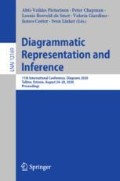Abstract
People make mistakes. Whether because lines are misdrawn, data are mistabulated, or because coffee is spilled on documents, diagrammatic representations may not be entirely correct. Yet experience tells that such diagrams are not entirely useless.
In this paper, we describe a semantic theory of representation, which naturally explains the utility of erroneous diagrams. In particular, the theory captures the possibility of obtaining true pieces of information from erroneous representations in a reliable manner.
We identify two dimensions along which there are choices in how to read a representation. In one dimension, we may read only part of the representation, avoiding the erroneous information. We call this partial reading. In the other, we focus on abstract properties of the representation, ignoring errors in the precision of the information represented. We call this abstract reading. Along either or both dimensions, true information can be obtained from erroneous diagrams.
The theory is based on Barwise and Seligman’s channel theory, and captures these different modes of readings in terms of multiple representation systems in which a diagram carries information about its target. On this theory, one and the same diagram can be accurate in one system and inaccurate in others, and the reader switches systems when they read the diagram in different modes.
Access this chapter
Tax calculation will be finalised at checkout
Purchases are for personal use only
Notes
- 1.
We thank an anonymous reviewer for drawing attention to the issue of apparent ubiquity of inexact diagrams.
References
Barwise, J., Seligman, J.: Information Flow: The Logic of Distributed Systems. Cambridge Tracts in Theoretical Computer Science. Cambridge University Press, Cambridge (1997). https://doi.org/10.1017/CBO9780511895968
Hammer, E.: Logic and Visual Information. CSLI Publications and the European Association for Logic, Language and Information, Stanford (1995)
Howse, J., Molina, F., Taylor, J., Kent, S., Gil, J.Y.: Spider diagrams: a diagrammatic reasoning system. J. Vis. Lang. Comput. 12, 299–324 (2001)
Lewis, D.: Languages and language. In: Philosophical Papers, pp. 93–115. Oxford UP, Oxford (1975/1985). Originally published in 1975
Millikan, R.G.: Language, Thought, and Other Biological Categories: New Foundation for Realism. The MIT Press, Cambridge (1984)
Pinker, S.: A theory of graph comprehension. In: Aritificial Intelligence and the Future of Testing, pp. 73–126. L. Erlbaum Associates, Hilsdale (1990)
Ratwani, R.M., Trafton, J.G., Boehm-Davis, D.A.: Thinking graphically: extracting local and global information. In: Proceedings of the Twenty-Fifth Annual Conference of the Cognitive Science Society, pp. 958–963 (2003)
Shimojima, A.: Semantic Properties of Diagrams and Their Cognitive Potentials. CSLI Publications, Stanford (2015)
Shimojima, A., Barker-Plummer, D.: The Barwise-Seligman model of representation systems: a philosophical explication. In: Dwyer, T., Purchase, H., Delaney, A. (eds.) Diagrams 2014. LNCS (LNAI), vol. 8578, pp. 231–245. Springer, Heidelberg (2014). https://doi.org/10.1007/978-3-662-44043-8_25
Shimojima, A., Barker-Plummer, D.: Channel-theoretic account of reification in representation systems. Logique & Analyse (2020, to Appear)
Shin, S.J.: The Logical Status of Diagrams. Cambridge University Press, Cambridge (1994)
Stapleton, G., Jamnik, M., Shimojima, A.: What makes an effective representation of information: a formal account of observational advantages. J. Log. Lang. Inf. 26(2), 143–177 (2017). https://doi.org/10.1007/s10849-017-9250-6
Tufte, E.R.: Envisioning Information. Graphics Press, Cheshire (1990)
Author information
Authors and Affiliations
Corresponding author
Editor information
Editors and Affiliations
Rights and permissions
Copyright information
© 2020 Springer Nature Switzerland AG
About this paper
Cite this paper
Shimojima, A., Barker-Plummer, D. (2020). Channel-Theoretic Account of the Semantic Potentials of False Diagrams. In: Pietarinen, AV., Chapman, P., Bosveld-de Smet, L., Giardino, V., Corter, J., Linker, S. (eds) Diagrammatic Representation and Inference. Diagrams 2020. Lecture Notes in Computer Science(), vol 12169. Springer, Cham. https://doi.org/10.1007/978-3-030-54249-8_10
Download citation
DOI: https://doi.org/10.1007/978-3-030-54249-8_10
Published:
Publisher Name: Springer, Cham
Print ISBN: 978-3-030-54248-1
Online ISBN: 978-3-030-54249-8
eBook Packages: Computer ScienceComputer Science (R0)

